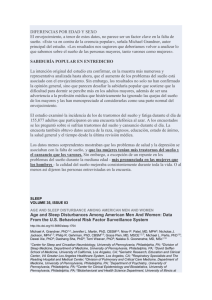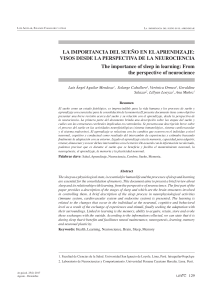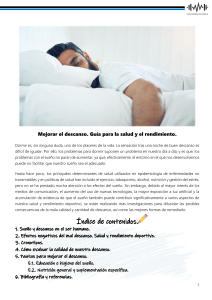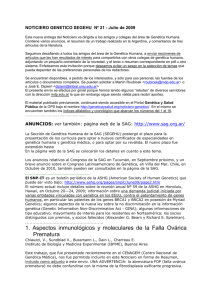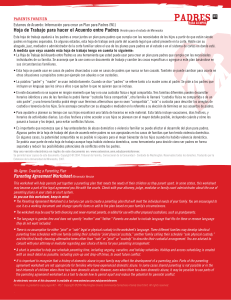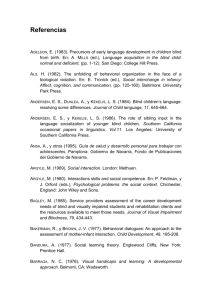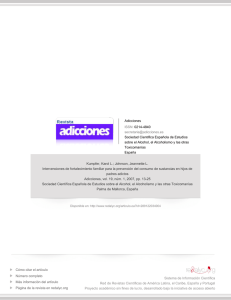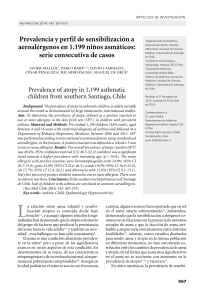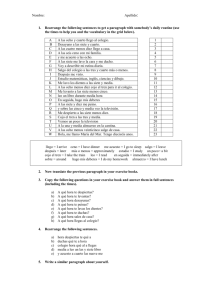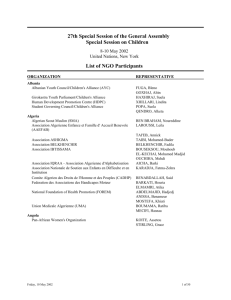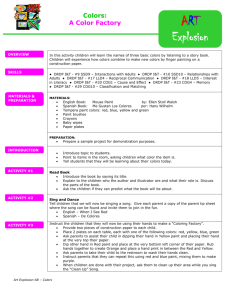MATERIA: INGLÉS
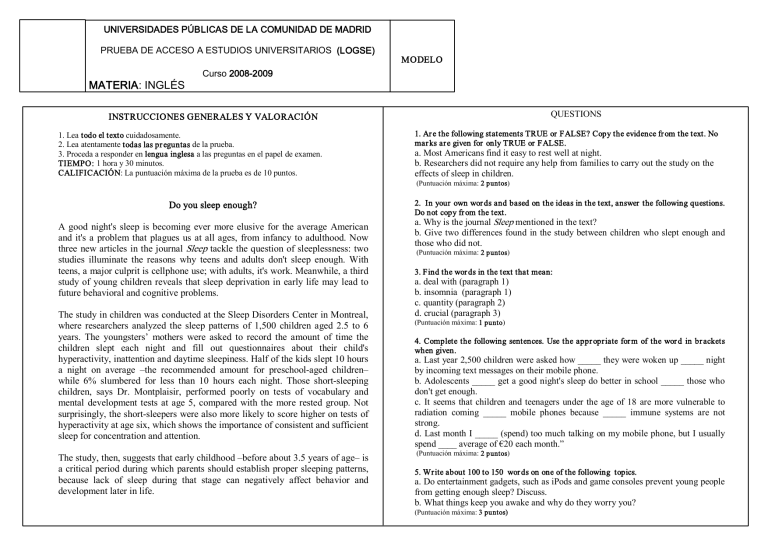
UNIVERSIDADES PÚBLICAS DE LA COMUNIDAD DE MADRID
PRUEBA DE ACCESO A ESTUDIOS UNIVERSITARIOS (LOGSE)
Curso 20082009
MATERIA: INGLÉS
INSTRUCCIONES GENERALES Y VALORACIÓN
1. Lea todo el texto cuidadosamente.
2. Lea atentamente todas las pr eguntas de la prueba.
3. Proceda a responder en lengua inglesa a las preguntas en el papel de examen.
TIEMPO: 1 hora y 30 minutos.
CALIFICACIÓN: La puntuación máxima de la prueba es de 10 puntos.
Do you sleep enough?
A good night's sleep is becoming ever more elusive for the average American and it's a problem that plagues us at all ages, from infancy to adulthood. Now three new articles in the journal Sleep tackle the question of sleeplessness: two studies illuminate the reasons why teens and adults don't sleep enough. With teens, a major culprit is cellphone use; with adults, it's work. Meanwhile, a third study of young children reveals that sleep deprivation in early life may lead to future behavioral and cognitive problems.
The study in children was conducted at the Sleep Disorders Center in Montreal, where researchers analyzed the sleep patterns of 1,500 children aged 2.5 to 6 years. The youngsters’ mothers were asked to record the amount of time the children slept each night and fill out questionnaires about their child's hyperactivity, inattention and daytime sleepiness. Half of the kids slept 10 hours a night on average –the recommended amount for preschoolaged children– while 6% slumbered for less than 10 hours each night. Those shortsleeping children, says Dr. Montplaisir, performed poorly on tests of vocabulary and mental development tests at age 5, compared with the more rested group. Not surprisingly, the shortsleepers were also more likely to score higher on tests of hyperactivity at age six, which shows the importance of consistent and sufficient sleep for concentration and attention.
The study, then, suggests that early childhood –before about 3.5 years of age– is a critical period during which parents should establish proper sleeping patterns, because lack of sleep during that stage can negatively affect behavior and development later in life.
MODELO
QUESTIONS
1. Ar e the following statements TRUE or FALSE? Copy the evidence fr om the text. No mar ks are given for only TRUE or FALSE. a. Most Americans find it easy to rest well at night. b. Researchers did not require any help from families to carry out the study on the effects of sleep in children.
(Puntuación máxima: 2 puntos)
2. In your own wor ds and based on the ideas in the text, answer the following questions.
Do not copy fr om the text. a. Why is the journal Sleep mentioned in the text? b. Give two differences found in the study between children who slept enough and those who did not.
(Puntuación máxima: 2 puntos)
3. Find the wor ds in the text that mean: a. deal with (paragraph 1) b. insomnia (paragraph 1) c. quantity (paragraph 2) d. crucial (paragraph 3)
(Puntuación máxima: 1 punto)
4. Complete the following sentences. Use the appr opriate for m of the wor d in br ackets when given. a. Last year 2,500 children were asked how _____ they were woken up _____ night by incoming text messages on their mobile phone. b. Adolescents _____ get a good night's sleep do better in school _____ those who don't get enough. c. It seems that children and teenagers under the age of 18 are more vulnerable to radiation coming _____ mobile phones because _____ immune systems are not strong. d. Last month I _____ (spend) too much talking on my mobile phone, but I usually spend ____ average of €20 each month.”
(Puntuación máxima: 2 puntos)
5. Write about 100 to 150 wor ds on one of the following topics. a. Do entertainment gadgets, such as iPods and game consoles prevent young people from getting enough sleep? Discuss. b. What things keep you awake and why do they worry you?
(Puntuación máxima: 3 puntos)
INGLÉS
SOLUCIONES
Suggested Answer s:
Question 1
1.a. False. A good night's sleep is becoming ever more elusive for the average American (and it's a problem that plagues us at all ages, from infancy to adulthood.)
1.b. False. The youngsters’ mothers were asked to record the amount of time the children slept each night and fill out questionnaires about their child's hyperactivity, inattention and daytime sleepiness.
Question 2
Key ideas
2.a. Because it has recently published three studies dealing with sleeplessness among people of all ages: adults, teenagers and children.
2.b. Children who slept less had a poorer vocabulary and less concentration than those who slept longer. They scored lower on tests of vocabulary and mental development, but they scored higher on tests of hyperactivity.
Question 3
3.a. tackle
3.b. sleeplessness
3.c. amount
3.d. critical
Question 4
4.a. often / many times Æ ............. at
4.b. who/that.............. than
4.c. from ..............their
4.d. on..............an
INGLÉS
CRITERIOS ESPECÍFICOS DE CORRECCIÓN
TIEMPO: 1 hora y 30 minutos
La prueba consistirá en el “análisis” de un texto de un idioma extranjero (el inglés en este caso), del lenguaje común, no especializado. A partir del texto propuesto, el estudiante realizará un comentario personal y responderá a cuestiones relacionadas con el texto, que serán planteadas y respondidas por escrito en el mismo idioma, sin ayuda de diccionario ni de ningún otro manual didáctico” (BOE n° 257). El texto contendrá alrededor de 250 palabras y su comprensión no exigirá conocimientos especializados ajenos a la materia de la prueba. La dificultad del texto estará controlada, a fin de permitir al alumno que realice la misma en el tiempo previsto. La puntuación total del examen será de 10 puntos. Al comienzo de la prueba se incluirán unas instrucciones generales para la realización de la misma en lengua castellana.
El resto de la prueba estará totalmente redactada en inglés, y el alumno usará exclusivamente la lengua inglesa en sus respuestas.
Valoración objetivos de cada una de las preguntas:
Pregunta 1: Hasta 2 puntos. Se trata de medir exclusivamente la comprensión lectora. El alumno deberá decidir si dos frases que se le presentan son verdaderas o falsas, copiando a continuación únicamente el fragmento del texto que justifica su elección. Se otorgará 1 punto por cada apartado. Se calificará con 0 puntos la opción elegida que no vaya justificada.
Pregunta 2: Hasta 2 puntos. Se pretende comprobar dos destrezas: la comprensión lectora y la expresión escrita, mediante la formulación de dos preguntas abiertas que el alumno deberá contestar basándose en la información del texto, pero utilizando sus propias palabras en la respuesta. Cada una de las preguntas valdrá 1 punto, asignándose 0,5 puntos a la comprensión de la pregunta y del texto, y 0,5 a la corrección gramatical de la respuesta.
Pregunta 3: Hasta 1 punto. Esta pregunta trata de medir el dominio del vocabulario en el aspecto de la comprensión. El alumno demostrará esta capacidad localizando en el párrafo/s que se le indica un sinónimo adecuado al contexto, de cuatro palabras o definiciones. Se adjudicará 0,25 por cada apartado.
Pregunta 4: Hasta 2 puntos. Con esta pregunta se pretenden comprobar los conocimientos gramaticales del alumno, en sus aspectos morfológicos y/o sintácticos. Se presentarán oraciones con huecos que el alumno deberá completar/rellenar. También podrán presentarse oraciones para ser transformadas, u otro tipo de item. Se adjudicará 0,25 a cada “hueco en blanco”, y en el caso de las transformaciones o items de otro tipo se concederá 0,5 con carácter unitario.
Pregunta 5: Hasta 3 puntos. Se trata de una composición de 100 a 150 palabras en la que el alumno podrá demostrar su capacidad para expresarse libremente en lengua extranjera. Se propondrán dos opciones entre las que el alumno elegirá solo una. Se otorgarán 1,5 puntos por el buen dominio de la lengua –léxico, estructura sintáctica, etc. y 1,5 por la madurez en la expresión de las ideas organización, coherencia y creatividad.
